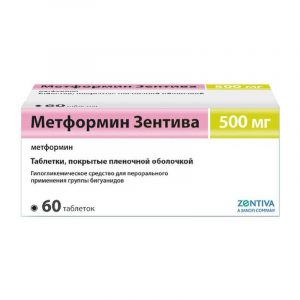Description
Latin name
Metglib Force
Pharmacological action
Hypoglycemic agent for oral administration (II-generation sulfonylurea derivative + biguanide).
Indications
Type 2 diabetes mellitus in adults:
– when diet therapy, exercise and previous monotherapy with metformin or sulfonylurea derivatives are ineffective – to replace the previous therapy with two drugs (metformin and a sulfonylurea derivative) in patients with stable and well-controlled levels.
Contraindications
Hypersensitivity to metformin, glibenclamide or other sulfonylurea derivatives, as well as other components of the drug, type 1 diabetes mellitus, diabetic ketoacidosis, diabetic precoma, diabetic coma, renal failure or impaired renal function (creatinine clearance less than 60 ml / min) acute conditions that can lead to a change in kidney function: dehydration, severe infection, shock, intravascular administration of iodine-containing contrast agents (see “Special Instructions”) acute or chronic diseases that are accompanied by tissue hypoxia her: heart or respiratory failure, recent myocardial infarction, liver failure of porphyria pregnancy, breast-feeding, concomitant use of miconazole infectious diseases, major surgical interventions, injuries, extensive burns and other conditions, requiring insulin therapy, chronic alcoholism, acute alcohol intoxication, lactic acidosis (including history), adherence to a low-calorie diet (less than 1000 kcal / day), children under 18 years of age.
It is not recommended to use the drug in people over 60 years old who perform heavy physical work, which is associated with an increased risk of developing lactic acidosis in them.
With caution
Fever syndrome adrenal insufficiency hypofunction of the anterior pituitary of the thyroid gland disease (with uncompensated impairment of its function) in the elderly due to the risk of hypoglycemia.
Use during pregnancy and during breastfeeding
During pregnancy, the use of the drug Metglib ® Force is contraindicated. The patient should be warned that that during the period of treatment with Metglib ® Force, it is necessary to inform the doctor about the planned pregnancy and the onset of pregnancy. When planning pregnancy, as well as in case of pregnancy during the period of taking the drug, it should be canceled and insulin therapy should be prescribed.
Metglib ® Force is contraindicated in breastfeeding, as there is no evidence of its ability to pass into breast milk. If it is necessary to use the drug during breastfeeding, you should switch to insulin therapy or stop breastfeeding.
Special instructions
Treatment with Metglib ® Force is carried out only under medical supervision! When taking the drug, it is necessary to strictly follow the doctor’s recommendations on dieting and self-monitoring of glucose concentration in the blood. It is necessary to regularly monitor the level of glycemia on an empty stomach and after eating.
Lactic acidosis
Lactic acidosis is an extremely rare, but serious (high mortality rate in the absence of emergency treatment) complication that may occur due to cumulation of metformin. Cases of lactic acidosis with the use of metformin occurred mainly in patients with diabetes mellitus and severe renal failure. Other associated risk factors should be considered, such as poorly controlled diabetes mellitus, ketosis, prolonged fasting, excessive alcohol consumption, liver failure, and any condition associated with severe hypoxia.
The risk of lactic acidosis should be considered when nonspecific symptoms such as muscle cramps accompanied by dyspeptic disorders, abdominal pain and severe malaise appear. In severe cases, acidotic shortness of breath, hypoxia, hypothermia, and coma may occur.
Diagnostic laboratory parameters are: low blood pH, plasma lactate concentration above 5 mmol / l, increased anionic interval and lactate / pyruvate ratio.
Hypoglycemia
Since Metglib ® Force contains glibenclamide, taking the drug is associated with a risk of hypoglycemia in the patient. Gradual titration of the dose after the start of treatment can prevent the occurrence of hypoglycemia. This treatment can only be prescribed to a patient who adheres to a regular meal (including breakfast). It is important that carbohydrate intake is regular as the risk of developing hypoglycemia increases with a late meal, inadequate or unbalanced carbohydrate intake. The development of hypoglycemia is most likely with a hypocaloric diet, after intense or prolonged physical activity, with alcohol, or with a combination of hypoglycemic agents.
Due to compensatory reactions caused by hypoglycemia, increased sweating, a sense of fear, tachycardia, increased blood pressure, a feeling of palpitations, angina pectoris and arrhythmia can occur. The latter symptoms may be absent if hypoglycemia develops slowly, in the case of autonomic neuropathy or while taking beta-blockers, clonidine, reserpine, guanethidine or sympathomimetics.
Other symptoms of hypoglycemia in patients with diabetes can include headache, hunger, nausea, vomiting, severe fatigue, sleep disorders, agitation, aggression, impaired concentration of attention and psychomotor reactions, depression, confusion, speech impairment, visual impairment, trembling, paralysis and paresthesia, dizziness, delirium, cramps, doubt, unconsciousness, shallow breathing and bradycardia.
Cautious use of the drug, dosage selection and proper instructions for the patient are important to reduce the risk of hypoglycemia. If the patient recurs attacks of hypoglycemia, which are either severe or associated with ignorance of the symptoms, consideration should be given to treatment with other hypoglycemic agents. Factors contributing to the development of hypoglycemia: the simultaneous use of alcoholic beverages, especially during fasting, refusal or (especially for elderly patients) the patient’s inability to interact with the doctor and follow the recommendations, set out in the instructions for use poor nutrition, irregular food intake, fasting or dietary changes, imbalance between physical activity and carbohydrate intake renal failure severe liver failure overdose of Metglib ® Force individual endocrine disorders: insufficiency of the thyroid gland, pituitary and adrenal glands preparations.
Renal and Hepatic Insufficiency
Pharmacokinetics and / or pharmacodynamics may vary in patients with hepatic impairment or severe renal impairment. The hypoglycemia that occurs in such patients can be prolonged, in which case appropriate treatment should be started.
Instability of blood glucose
In case of surgical intervention or other cause of decompensation of diabetes mellitus, it is recommended to provide a temporary transition to insulin therapy. Symptoms of hyperglycemia are frequent urination, severe thirst, dry skin. 48 hours before the planned surgical intervention or intravenous administration of an iodine-containing radiopaque agent, Metglib ® Force should be discontinued. Treatment is recommended to be resumed after 48 hours, and only after renal function has been evaluated and recognized as normal.
Renal function
Since metformin is excreted by the kidneys, before starting treatment and regularly thereafter, creatinine clearance and / or serum creatinine must be determined: at least once a year in patients with normal renal function, and 2-4 times a year in elderly patients, as well as in patients with creatinine clearance at the upper limit of normal.
It is recommended to be especially careful in cases where kidney function may be impaired, for example, in elderly patients, or in the case of initiation of antihypertensive therapy, diuretics or non-steroidal anti-inflammatory drugs (NSAIDs).
Other Precautions
The patient should inform the doctor of a bronchopulmonary infection or an infectious disease of the genitourinary system.
Influence on the ability to drive vehicles and work with mechanisms
Patients should be informed about the risk of hypoglycemia and should observe safety precautions when driving and working with mechanisms that require increased concentration and speed of psychomotor reactions.
Composition
1 film-coated tablet 2.5 mg + 500 mg contains:
active ingredients:
glibenclamide 2.5 mg + metformin hydrochloride 500 mg
excipients:
corn starch 56.5 mg
cal tion hydrogen phosphate dihydrate 62.5 mg,
Sodium croscarmellose 15 mg,
macrogol (polyethylene glycol 6000) 15 mg,
Povidone K-30 50 mg,
4 mg sodium stearyl fumarate,
microcrystalline cellulose 44.5 mg
film coat:
Opadray orange 25 mg, including: [hypromellose (hydroxypropyl methylcellulose) 8.438 mg, hyprolysis (hydroxypropyl cellulose) 8.437 mg, talc 5 mg, titanium iron oxide 2.795 mg, dye yellow 0.275 mg, dye iron oxide red 0.055 mg].
Dosage and Administration
Inside.
The dose of the drug is determined by the doctor individually for each patient, depending on the level of glycemia.
The initial dose is 1 tablet of Metglib® Force 2.5 mg + 500 mg or Metglib® Force 5 mg + 500 mg once a day. In order to avoid hypoglycemia, the initial dose should not exceed the daily dose of glibenclamide (or the equivalent dose of another previously taken sulfonylurea drug) or metformin, if they were used as first-line therapy. It is recommended to increase the dose by no more than 5 mg of glibenclamide + 500 mg of metformin per day every 2 or more weeks to achieve adequate control of blood glucose.
Substitution of previous combination therapy with metformin and glibenclamide: the initial dose should not exceed the daily dose of glibenclamide (or the equivalent dose of another sulfonylurea) and metformin taken previously. Every 2 or more weeks after the start of treatment, the dose is adjusted depending on the level of glycemia.
The maximum daily dose is 4 tablets of Metglib® Force 5 mg + 500 mg or 6 tablets of Metglib® Force 2.5 mg + 500 mg.
Dosage regimen:
The dosage regimen depends on the individual purpose:
For dosages 2, 5 mg + 500 mg and 5 mg + 500 mg
– Once a day, in the morning during breakfast, with the appointment of 1 tablet per day.
– Twice a day, morning and evening, with 2 or 4 tablets per day.
For a dosage of 2.5 mg + 500 mg
– Three times a day, in the morning, afternoon and evening, with the appointment of 3, 5 or 6 tablets per day.
For a dosage of 5 mg + 500 mg
– Three times a day, in the morning, afternoon and evening, with the appointment of 3 tablets per day.
Tablets should be taken with meals. Each meal should be accompanied by a meal with a high enough carbohydrate content to prevent the occurrence of hypoglycemia.
Elderly patients
The dose of the drug is selected based on the state of renal function. The initial dose should not exceed 1 tablet of Metglib® Force 2.5 mg + 500 mg. Regular assessment of renal function is necessary.
Children
Metglib® Force is not recommended for use in children.
Side effects
The following adverse reactions may occur during treatment with Metglib ® Force.
WHO Classification of Adverse Reactions:
very often -? 1/10 appointments
often – from? 1/100 to <1/10 appointments infrequently – from 1/1000 to rarely -? 1/10000 to very rarely – Classification of adverse reactions in accordance with damage to organs and organ systems (medical dictionary for regulatory activity Med-DRA). Disorders from the blood and lymphatic system: These adverse events disappear after discontinuation of the drug. Rarely: leukopenia and thrombocytopenia. Very rare: agranulocytosis, hemolytic anemia, bone marrow aplasia, and pancytopenia. Immune system disorders: Very rare: anaphylactic shock. Cross-hypersensitivity reactions to sulfonamides and their derivatives may occur. Metabolism and nutritional disorders: Hypoglycemia (See “Overdose”, “Special Instructions”). Rarely: attacks of porphyria (hepatic or cutaneous). Very rare: lactic acidosis (See “Special instructions”). Decreased absorption of vitamin B12, accompanied by a decrease in its concentration in serum with prolonged use of metformin. If megaloblastic anemia is detected, the possibility of such an etiology must be considered. Disulfiram-like reaction with ethanol. Disorders of the nervous system: Often: taste disturbance ( metallic taste in the mouth). Disorders of the organ of vision: Initial treatment may cause temporary visual impairment due to a decrease in blood glucose. Disorders of the gastrointestinal tract: Very often: nausea, vomiting, diarrhea, abdominal pain and lack of appetite. These symptoms are more common at the beginning of treatment and in most cases pass on their own. Infrequently: a feeling of heaviness and overflow in the stomach, belching. To prevent the development of these symptoms, it is recommended to take the drug in 2 or 3 doses, a slow increase in the dose of the drug also improves its tolerance. Disorders of the liver and biliary tract: Very rarely: impaired liver function or hepatitis requiring discontinuation of treatment. Disorders of the skin and subcutaneous tissue: Rarely: skin reactions, such as: pruritus, urticaria, maculopapular rash. Very rare: photosensitivity, skin or visceral allergic vasculitis, polymorphic erythema, exfoliative dermatitis. Laboratory and instrumental data: Infrequently: moderate increase in serum urea and creatinine concentrations Very rare: hyponatremia. Drug interactions Contraindicated combinations Associated with the use of glibenclamide Miconazole can provoke the development of hypoglycemia (up to the development of coma). Associated with the use of metformin Iodine-containing contrast agents: depending on renal function, the drug should be discontinued 48 hours before or after intravenous administration of iodine-containing contrast agents. Not recommended combinations Associated with the use of sulfonylurea derivatives Alcohol: a disulfiram-like reaction (intolerance to alcohol) is very rarely observed while taking alcohol and glibenclamide. Alcohol can increase the hypoglycemic effect (by inhibiting the compensatory reactions or by delaying its metabolic inactivation), which may contribute to the development of hypoglycemic coma. During the treatment with Metglib ® Force, alcohol and medications containing ethanol should be avoided. Bozentan in combination with glibenclamide increases the risk of hepatotoxicity. It is recommended that you avoid taking these drugs at the same time. The hypoglycemic effect of glibenclamide may also decrease. Phenylbutazone increases the hypoglycemic effect of sulfonylurea derivatives (replacing sulfonylurea derivatives in places associated with protein and / or reducing their elimination). It is preferable to use other anti-inflammatory drugs that show less interaction, or to warn the patient about the need to independently control the level of glycemia if necessary, the dose should be adjusted when the anti-inflammatory drug is used together and after it is stopped. Metformin-related Alcohol: The risk of developing lactic acidosis is enhanced by acute alcohol intoxication, especially in case of starvation, or poor nutrition, or liver failure. During the treatment with Metglib ® Force, alcohol and medications containing ethanol should be avoided. Combinations requiring caution Associated with all hypoglycemic agents Chlorpromazine: at high doses (100 mg / day) causes an increase in glycemia (reducing insulin release). Precautions: you should warn the patient about the need for self-monitoring of blood glucose if necessary, adjust the dose of hypoglycemic agent during the simultaneous use of antipsychotics and after stopping its use. Glucocorticosteroids (GCS) and tetracosactide: an increase in blood glucose, sometimes accompanied by ketosis (GCs cause a decrease in glucose tolerance). Precautions: the patient should be warned about the need for self-monitoring of blood glucose if necessary, the dose of the hypoglycemic agent should be adjusted during the simultaneous use of GCS and after stopping their use. Danazole has a hyperglycemic effect. If treatment with danazol is necessary and when the latter is stopped, dose adjustment of the Metglib ® Force drug is required under the control of glycemia level. ? 2-adrenergic agonists: due to the stimulation of? 2-adrenergic receptors increase the concentration of glucose in the blood. Precautions: it is necessary to warn the patient and establish control of blood glucose, possible transfer to insulin therapy. Diuretics: increased blood glucose. Precautions: you should warn the patient about the need for self-monitoring of glucose in the blood may require dose adjustment of hypoclycemic drugs during simultaneous use with diuretics and after the cessation of their use. Angiotensin-converting enzyme (ACE) inhibitors (captopril, enalapril): the use of ACE inhibitors helps to reduce blood glucose. If necessary, the dose of Metglib ® Force should be adjusted during simultaneous use with ACE inhibitors and after stopping their use. Associated with the use of metformin Diuretics: Lactic acidosis resulting from the use of metformin against functional renal failure caused by the use of diuretics, especially loopback. Glibenclamide-related ? 2-blockers, clonidine, reserpine, guanethidine, and sympathomimetics mask some symptoms of hypoglycemia: palpitations and tachycardia, most non-selective beta-blockers increase the incidence and severity of hypoglycemia. The patient should be warned about the need for independent monitoring of blood glucose, especially at the beginning of treatment. Fluconazole: An increase in the half-life of glibenclamide with the possible occurrence of manifestations of hypoglycemia. The patient should be warned about the need for independent monitoring of blood glucose levels. It may be necessary to adjust the dose of hypoglycemic drugs during the simultaneous treatment with fluconazole and after stopping its use. Other interactions: combinations to consider: Associated with glibenclamide Desmopressin: Metglib ® Force may reduce the antidiuretic effect of desmopressin. Antibacterial drugs from the group of sulfonamides, fluoroquinolones, anticoagulants (coumarin derivatives), MAO inhibitors, chloramphenicol, pentoxifylline, lipid-lowering drugs from the group of fibrates, disopyramides – the risk of hypoglycemia with the use of glibenclamide. Overdose of In case of an overdose, hypoglycemia may develop due to the presence of a sulfonylurea derivative in the preparation (see “Special Instructions”). Mild to moderate symptoms of hypoglycemia without loss of consciousness and neurological manifestations can be corrected by immediate consumption of sugar. It is necessary to carry out dose adjustment and / or change the diet. The occurrence of severe hypoglycemic reactions in patients with diabetes, accompanied by coma, convulsions or other neurological disorders, requires emergency medical care. Intravenous administration of a dextrose solution is necessary immediately after diagnosis or suspicion of hypoglycemia occurs, before the patient is hospitalized. After regaining consciousness, you need to eat food, rich in easily digestible carbohydrates (to avoid the re-development of hypoglycemia). Plasma glibenclamide clearance may increase in patients with liver disease. Since glibenclamide is actively associated with blood proteins, the drug is not excreted during dialysis. An overdose or the presence of conjugated risk factors can provoke the development of lactic acidosis, as metformin is part of the drug (see “Special Instructions”). Lactic acidosis is a condition requiring emergency medical care treatment of lactic acidosis should be carried out in a hospital. The most effective treatment option to remove lactate and metformin is hemodialysis. Storage Conditions In a dry, dark place at a temperature not exceeding 25 ° C. Keep out of reach of children. Expiration 2 years. Do not use after the expiry date. active substance Glibenclamide, Metformin The dosage form of tablet Kanonfarma, Russia




